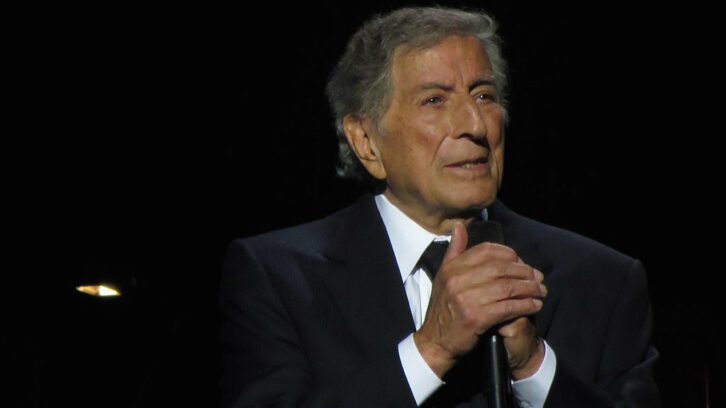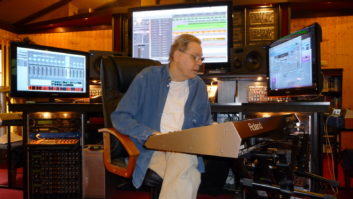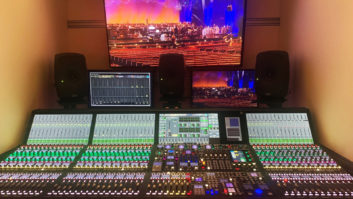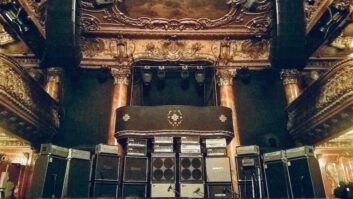
From the November 2006 issue of Pro Sound News.
Tony Bennett’s contribution to recorded music during the last century is immeasurable. His rare ability to impart a distinctive—and instantly recognizable—mood to every song he sings has earned the greatest respect of his contemporaries. Not surprisingly, the success Mr. Bennett achieves in the studio has less to do with the equipment being used than his enduring, and seemingly effortless, vocal performances.
On his latest album, Duets—An American Classic, which broke the Billboard top 10 album chart just weeks after his 80th birthday, Bennett shares the mic with many of the world’s most successful pop artists—indeed, every person on the record has made a permanent contribution to the genre. While each of the artists on the record have likely spent hundreds of hours at the world’s top studios, they may have learned a thing or two from Mr. Bennett about technique; for starters, the vast majority of the record was recorded live.
On the Concept of a Duet Album
I was a little apprehensive when my son Danny came up with the whole idea, but once we started getting these phenomenal, institutional artists—you know, people who are going to be around for the next thirty, forty years—I just got a big kick out of it. As soon as NBC heard we were doing it, they wanted to do a special TV show as well.
We gave each artist four songs of mine, so they could choose one that they really liked personally. The main thing we were looking for was contrast in voices. A good duet album has voices that are different from one another; the same principle applies to live performance. We arranged the songs to the appropriate keys and matched the harmonies so they sounded just right.
On Preserving an Approach that Works
When I first started about 50 years ago on Columbia, there was no splicing. You couldn’t take the first performance, put it on take 15 and splice it together so it sounds like one record, for example. You had to memorize the song so you could sing it from the beginning to end. To be honest with you, the public would get a real good shot of the artist because they received a full performance of the song. The take that you would hear is the one that went down on tape, just like a regular solo performance.
As a result, through the years, I stuck with that approach because it was just better. To make an analogy, I visited the Library of Congress in Washington, D.C. recently and found that the older items on the shelves were made of better materials. For example, the earliest books were written on cloth and they were hand-printed; they were made to last forever, you see.
On Capturing the Performance
The artists I was working with on this record weren’t expecting to record live. When I said after only three takes or so, “That’s great; that’s just right,” their eyes lit up and they said, “You’re kidding!” I would say, “Why are you looking at me like that?” And they would reply, “Well, we usually take like 25 weeks to record,” and they’d be adding a trumpet, a piano or whatever else to make it just perfect. I said, “No, no. Singing jazz through the years with greats like Stan Getz, Bill Evans or Count Basie, I’ve found that throughout my whole catalog, the more spontaneous it is, the better the record becomes.”
I told them that a live performance on a record is more vibrant, more permanent and that it never gets dated; it doesn’t get filtered in any way. After all, when it starts sounding like it’s too perfect, there is something wrong with it—there needs to be a little dirt in there. If you do it in 15 takes, looking for perfection, you’re not really going to get it because the musicians get tired after five or six takes. They don’t want to have to play it again, again and again, making it tedious. I look at this album as the first vocal jam session; it was done spontaneously, and everyone involved did it in three or four takes.
On Recording “Smile” with Barbara Streisand
We did that song at her home out in Malibu on a beautiful day. We recorded it in one or two takes in her living room, which happens to have a spectacular view of the ocean. Barbara didn’t really understand why I chose that particular song, so I explained that even though the song was written 30 years ago by Charlie Chaplin for the movie City Lights, it still has particular relevance today because of 9/11. Take the lyrics “When there are clouds in the sky, you’ll get by if you just keep smiling.” It’s all about pulling through. I said, ‘Barbara, this is the kind of thing you believe in!” I got through to her, and she sung it beautifully—she smacked it right out of the ballpark.
On Singing with Paul, Elton and on Being a Professional
Paul and I get along great – he’s such a natural. I’ve known him since the early Sixties when I gave the Beatles their first music award, before they became such a phenomenon. He really wanted to do “The Very Thought of You” by Ray Noble. Ray Noble is the Cole Porter of Britain—he wrote the best songs, and at the same level as Cole Porter did during the Great American Songbook era.
Elton John was so prepared that he did it in one take! He came in, sat down at the piano, played “Rags to Riches” once, and then said ‘Let’s do one.’ After we did it, I turned to him and said “You can’t get better than that!” Frankly, I was surprised at the performance of all of them, because unfortunately, when you get to be my age, a sort of attitude sets in among musicians—”It’s not as good as it used to be” and that sort of thing. Actually, what I found out was that all of these people were professional. They were ready on time, they knew what they were doing, and loved doing it.
On Bennett Studios and Working with his Son, Dae
This album we did in the studio, but every other record I’ve done at Bennett Studios was done in the theater. The studio is built with kind of an old-school sound, so acoustically it’s perfect with a reverberation that sounds very natural. I’ve met so many great jazz musicians there, and they love it as well. That’s the real reason I like it: People are comfortable there and so am I.
Dae knows when something is right or when it’s not right. He gets the best sound for me, and if something’s not right, he speaks up. I’m also in on the mixing with him. Whatever I hear in the rough mix, he just hones right in on.







